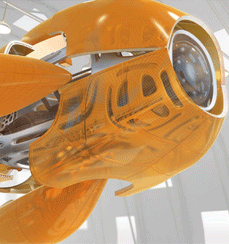THANK YOU FOR SUBSCRIBING
 Greg Fallon, Vice President of Simulation Products
Greg Fallon, Vice President of Simulation ProductsAutodesk has a wide range of standalone simulation products like Autodesk Nastran for mechanical, Autodesk Robot Structural Analysis for architectural structures, Autodesk CFD for fluid flow, Autodesk Helius for composite analysis, and Autodesk Moldflow for injection molding simulation. By simulating a product design, users can virtually test and evaluate multiple designs to understand how they will perform under different loads and environmental conditions. Simulation allows a user to review the impact of different materials on the resulting product performance. It empowers a company to balance material and manufacturing costs with product performance to ultimately choose the configuration that meets design requirements as well as business objectives.
The user can simulate various manufacturing processes to determine feasibility and estimate the manufacturing costs before taking a risk by investing in specialized equipment, tooling, and material.
Simulation of product performance early in the design phase provides the opportunity to remove the risk of costly tool changes during production and the need for extensive prototyping.
By leveraging Autodesk’s cloud capabilities, users have instant access to infinite computing resources. Cloud computing enables users to evolve beyond analyzing a single design and minimum requirements and simultaneously, evaluate a vast array of designs and conditions to identify the best option. By having the ability to evaluate a large set of design options at the same time, companies gain tremendous insights into how their products perform and fail. The Autodesk cloud removes the burden from companies to purchase and maintain additional computing resources and provides elastic capacity as demands dictate.
Autodesk’s Fusion360 is an embodiment of the firm’s vision to accelerate, as well as bridge, functional process gaps that are prevalent within product design and development processes today. The offering houses capabilities that essentially revolutionize the approach for design and simulation. While simulation generally relates to ‘virtualized testing,’ Fusion360 imparts powerful, suggestive capabilities, banking upon the novel concept of generative design technologies, which is widely regarded as the ‘future’ of manufacturing-based design. The technology places numerous design ideas based on the design parameters and constraints of the product at the design engineer’s disposal. Generative design appends the ‘smart’ tag to design and simulation apps. As proponents of the technology, the innovation labs at Autodesk have brought together cutting-edge AI tools, access to powerful cloud processing, seamless cross-compatibility, and an affordable pricing model to render Fusion360 as a one of its kind offering in the space. With the pay-for-usage pricing model—wherein subscribers need to pay only for the design ideas they choose to work further upon—and readily available cloud-based computing resources capable of running thousands of intensive design simulations, Fusion360 immensely democratizes itself.
Simulation of product performance early in the design phase provides the opportunity to remove the risk of costly tool changes during production and the need for extensive prototyping.
By leveraging Autodesk’s cloud capabilities, users have instant access to infinite computing resources. Cloud computing enables users to evolve beyond analyzing a single design and minimum requirements and simultaneously, evaluate a vast array of designs and conditions to identify the best option. By having the ability to evaluate a large set of design options at the same time, companies gain tremendous insights into how their products perform and fail. The Autodesk cloud removes the burden from companies to purchase and maintain additional computing resources and provides elastic capacity as demands dictate.
Autodesk’s Fusion360 is an embodiment of the firm’s vision to accelerate, as well as bridge, functional process gaps that are prevalent within product design and development processes today. The offering houses capabilities that essentially revolutionize the approach for design and simulation. While simulation generally relates to ‘virtualized testing,’ Fusion360 imparts powerful, suggestive capabilities, banking upon the novel concept of generative design technologies, which is widely regarded as the ‘future’ of manufacturing-based design. The technology places numerous design ideas based on the design parameters and constraints of the product at the design engineer’s disposal. Generative design appends the ‘smart’ tag to design and simulation apps. As proponents of the technology, the innovation labs at Autodesk have brought together cutting-edge AI tools, access to powerful cloud processing, seamless cross-compatibility, and an affordable pricing model to render Fusion360 as a one of its kind offering in the space. With the pay-for-usage pricing model—wherein subscribers need to pay only for the design ideas they choose to work further upon—and readily available cloud-based computing resources capable of running thousands of intensive design simulations, Fusion360 immensely democratizes itself.
Fusion360 is designed to effectively streamline and remove friction between various stages of product development by letting ‘data flow seamlessly’ as Fallon mentions. For instance, generative design within Fusion360 can unify a design engineer’s vision on the aesthetic and structural integrity of a product, with the functionality view-point that a manufacturing engineer may envision on the product design. This eliminates the prevalent, time-consuming shuttling of designs across various functional teams in the manufacturing product development phase. Fusion360 enables users to generate tool paths for a variety of machines which can bring clarity into the post-design phase of a product.

Perhaps the most exciting capability that comes from the intersection of simulation-driven design and infinite computing is the ability for the system to participate in the design process, essentially redefining the ‘A’ in Computer-Aided Engineering. As simulation becomes more entwined in the design process, the chronological sequence of design evolution followed by validation is replaced by simulation guiding the birth and evolution of the design itself. Today, users can simply begin by specifying an envelope with appropriate constraints and allow the software to come up with the best possible design iteratively. They can then finetune their design to meet their manufacturing constraints and achieve near-optimal solutions to meet their customers’ unique needs. Companies that adapt and embrace technology, which fosters innovation along with the ability to make better decisions, will have opportunities to transform entire industries. Autodesk is fully embracing this new reality and is helping companies make what was previously impossible, possible.

Perhaps the most exciting capability that comes from the intersection of simulation-driven design and infinite computing is the ability for the system to participate in the design process, essentially redefining the ‘A’ in Computer-Aided Engineering. As simulation becomes more entwined in the design process, the chronological sequence of design evolution followed by validation is replaced by simulation guiding the birth and evolution of the design itself. Today, users can simply begin by specifying an envelope with appropriate constraints and allow the software to come up with the best possible design iteratively. They can then finetune their design to meet their manufacturing constraints and achieve near-optimal solutions to meet their customers’ unique needs. Companies that adapt and embrace technology, which fosters innovation along with the ability to make better decisions, will have opportunities to transform entire industries. Autodesk is fully embracing this new reality and is helping companies make what was previously impossible, possible.
July 18, 2019

I agree We use cookies on this website to enhance your user experience. By clicking any link on this page you are giving your consent for us to set cookies. More info













